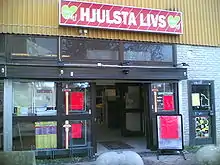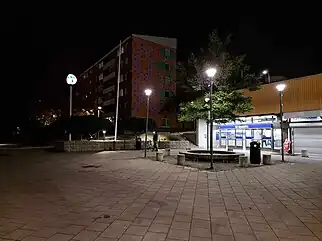
Hjulsta, a suburb of Stockholm known for its working-class roots, is often associated with Tensta but boasts its own subway station. This station, the terminal point of the blue line, has been operational since 1975.
The name ‘Hjulsta’ for the contemporary urban area is derived from an ancient village that existed in the vicinity since at least the 1480s.


The artwork adorning the station is the collective effort of various artists. This includes ‘Sjöfåglar’ by Christina Rundqvist-Andersson, ‘Sista skörden i norra Botkyrka’ by Olle Magnusson, and ‘Landbyska verken vid Engelbrektsplan år 1890’ by Ruth Rydfeldt.
History
Hjulsta Gård which has been changed to Hjulsta, was known for its farm and village since the 1480s, is situated south of Enköpingsvägen, approximately 600 meters from the Hjulsta junction. The farm was initially part of Ålstens gård during the 1600s and 1700s before becoming part of Åkeshov. The village, once home to several cottages, was unfortunately demolished in the late 1960s.
Hjulsta square[1] is the location of the entrance to the Hjulsta subway station. A football field can be found in the direction of E18. The area is predominantly filled with four-story rental buildings. In spring 2008, two new high-rise buildings were completed and ready for residents. These apartment buildings were originally owned by Svenska Bostäder but were sold to real estate company Einar Mattsson in the summer of 2008.
Beyond the rental properties, Hjulsta Backar street is home to 14 privately owned townhouses. These houses were ready for residents in 2007 and were all sold within the same year. These townhouses were constructed as part of the Tensta Housing Fair 2006, also known as TenstaBo 06, which took place from August 17 to August 27, 2006 in the Tensta district.
One could reach Hjulsta via the country road (now Enköpingsvägen) or by water. Long ago, Spångaån constituted a narrow waterway to travel on, as the river formed a slender bay of Mälaren. Those who lived here arrived by boat more than a thousand years ago. Archaeological excavations have proven that people from the Viking Age and even earlier lived in the vicinity of Hjulsta. Hjulsta has been inhabited by farmers since the early Middle Ages.

Hjulsta farm and village have been known since the 1480s. It was located south of today’s Enköpingsvägen, about 600 meters south of the Hjulsta junction. The oldest written records report two homesteads that were owned by different noble families for a long time. The farm belonged to Ålstens farm in the 1600s and 1700s, thereafter the farm belonged to Åkeshov Castle. The two homesteads were farmed under both Ålsten and Åkeshov among others. The village had several cottages, but was demolished at the end of the 1960s. The Stora Tensta farm in the Stora Tensta block was demolished in 1966.
The name Hjulsta
In 1486, the village of Hjulsta was spelled ‘i hiwlista’. The suffix of the name likely includes the plural of the Old Swedish word ‘stadher’, which means place or location. How the prefix should be interpreted is very uncertain. Previously, it has been assumed that the ‘Hjul-’ found in several Swedish place names would correspond to the unverified Old Swedish nickname ‘Hiule’.
Hjulstaschool
Hjulsta Grundskola F-9 (preschool to grade 9) is the municipal primary school in the area, a merger of the two previous schools, Hyllingeskolan and Hjulstaskolan.
Today, Hjulstaskolan is a primary school in western Tensta with approximately 400 students. It was built in 1971 based on designs by Åke Östin. The schoolyard is large, open, and paved with bushes along the facades and occasional trees. There is a ball field and a basketball court, and benches are located on the outer edges. The school is situated 100 meters from Hjulsta subway station, which is served by the blue line, and a 600-meter walk from the school begins the nature area Järvafältet
Hjulsta Metro station
The subway station is served by T-bana 3 (blue line). The station was put into operation on August 31, 1975, when the first part of the Blue line was inaugurated. The entrance is from the southern end at Hjulsta square.
Adjacent to Hjulsta, there is a Frisbee golf course and Hjulsta allotment garden.
See also
References
- ↑
 Hjulsta Square
Hjulsta Square

59°23′48″N 17°53′59″E / 59.39667°N 17.89972°E